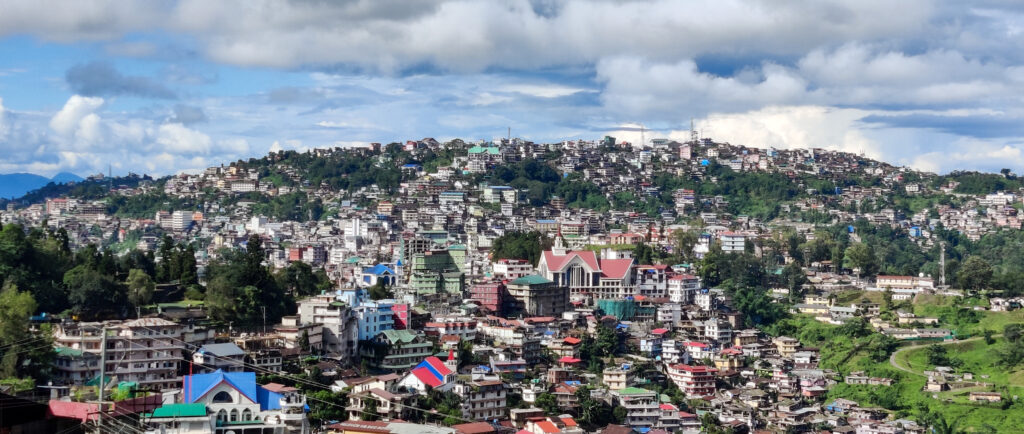
Image Source: The Anonymous Earthling
Nagaland, located in northeastern India, is a hilly state bordered by Assam, Arunachal Pradesh, Myanmar, and Manipur. Known for its tribal heritage, vibrant festivals, and scenic landscapes, Nagaland is home to 16 major tribes, each with its own distinct culture, language, and customs.
The capital, Kohima, blends administrative importance with scenic beauty, while Dimapur, the largest city, serves as the main gateway to the state. Nagaland offers a unique mix of adventure, culture, and nature, making it a must-visit for travelers seeking offbeat and authentic experiences.
Table of Contents
ToggleGeography
Nagaland is a land of rolling hills, valleys, and rivers, forming part of the Patkai range. Key geographic features include:
Hilly Terrain: Altitudes ranging from 194 m to 3,048 m above sea level, offering panoramic landscapes.
Rivers and Waterfalls: The Doyang, Dhansiri, and Tizu rivers, with several scenic waterfalls like Shilloi Lake.
Dense Forests: Rich biodiversity with tropical and subtropical flora.
Climate: Moderate climate, with cool summers, monsoon rains (June–September), and mild winters.
History
Nagaland has been inhabited by Naga tribes for centuries, maintaining distinct social structures and customs.
Colonial Era: The British administration engaged with Naga tribes mainly for trade and missionary work.
Post-Independence: Nagaland became the 16th state of India in 1963, after prolonged negotiations recognizing tribal autonomy.
The region preserves tribal heritage, oral histories, and traditional crafts, making it a living repository of Naga culture.
Culture and Festivals
Nagaland is famous for its rich tribal culture, music, and festivals:
Hornbill Festival: Held every December in Kisama, showcasing Naga dance, music, crafts, and cuisine.
Sekrenyi Festival (Angami Tribe): Celebrated in February as a purification and sowing festival.
Aoling Festival (Konyak Tribe): Marks the start of the sowing season in April.
Moatsu Festival (Ao Tribe): Celebrated in May with traditional music, dance, and feasts.
Other cultural elements include traditional Naga attire, beadwork, headgear, and woodcraft, with each tribe having unique symbols and rituals.
Popular Dishes of Nagaland
Naga cuisine is spicy, flavorful, and locally sourced:
Smoked Pork & Bamboo Shoot Curry: A Naga staple with earthy flavors.
Axone (Fermented Soybean): Used in curries for a distinct taste.
Raja Mircha (King Chili) Dishes: Extremely spicy dishes featuring the local chili variety.
Rice & Fish Curry: Staple meal across the state.
Local Snacks: Sticky rice dumplings, smoked meats, and wild greens.
Best Places to Visit in Nagaland
Kohima
Kohima War Cemetery: Tribute to soldiers of World War II.
State Museum: Exhibits tribal artifacts, traditional attire, and handicrafts.
Shilloi Lake: Scenic spot for nature lovers.
Dimapur
Dzukou Valley: Trekking paradise with blooming flowers and meadows.
Kachari Ruins: Historical remnants of medieval kingdoms.
Nagaland Zoological Park: Preserves native wildlife species.
Mon District
Mokokchung: Cultural hub with Ao tribe heritage.
Monyu Village & Longwa Village: Experience traditional Naga tribal life.
Wokha District: Known for natural beauty, hills, and rivers.
Tuensang & Phek
Nagaland Adventure Spots: Trekking, river exploration, and tribal village visits.
Khonoma Village: Eco-village famous for conservation and community tourism.
Top Things to Do in Nagaland
Attend the Hornbill Festival: Experience tribal music, dance, and crafts.
Trekking & Hiking: Explore Dzukou Valley, Japfu Peak, and Intanki National Park.
Cultural Exploration: Visit tribal villages and interact with locals.
Birdwatching & Wildlife: Rich biodiversity in forests and wetlands.
Photography: Capture traditional festivals, scenic valleys, and tribal art.
Local Markets & Handicrafts: Buy woven textiles, bamboo crafts, and beadwork.
Offbeat Places to Visit
Dzuleke: Scenic village with pine forests and rolling hills.
Chizami Village: Explore Ao Naga culture and handwoven textiles.
Aghunato: Peaceful hill station with trekking opportunities.
Phomching & Pangti: Eco-tourism and birdwatching hotspots.
Souvenirs to Buy
Traditional Naga handwoven shawls and textiles.
Bead necklaces, headgear, and ornaments.
Bamboo and cane handicrafts.
Locally made herbal oils and organic spices.
Traditional pottery and musical instruments.
Best Time to Visit Nagaland
October to March: Cool, dry, and perfect for trekking, sightseeing, and festivals.
April to June: Moderate temperatures, ideal for nature walks and village tours.
July to September (Monsoon): Heavy rainfall; some trekking paths may be slippery.
How to Reach Nagaland
By Air:
Dimapur Airport: Main entry point with flights from Kolkata, Guwahati, and Delhi.By Rail:
Dimapur Railway Station: Connects with major Indian cities.By Road:
Well-connected via highways from Assam , buses and taxis available for intra-state travel.Local Transport: Shared taxis, jeeps, and hired vehicles are common for hill routes.
Why Visit Nagaland
Nagaland is a blend of rugged natural beauty and vibrant tribal culture. From rolling hills, pristine valleys, and lush forests to colorful festivals and traditional villages, it offers an authentic, offbeat experience. Its unique tribal heritage, adventure opportunities, and ecological richness make Nagaland one of India’s most captivating and culturally immersive destinations .
Whether you want to trek the Dzukou Valley, witness the Hornbill Festival, or explore remote villages, Nagaland promises unforgettable experiences in a mystical and serene environment.
